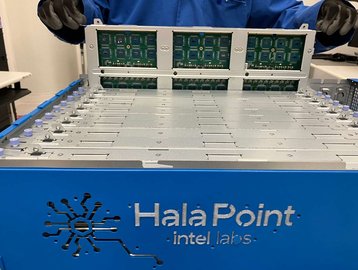Intel has built the world's largest neuromorphic system, a computing system that is modelled after the human brain and nervous system.
Code named Hala Point, the 1.15 billion neuron system advances the work achieved by the company’s first-generation large-scale research system, Pohoiki Springs, providing 10X more neuron capacity and 12X higher performance.
The 20 petaops (not to be confused with petaflops) system is housed at the Department of Energy’s (DOE) Sandia National Labs. It consists of 1,152 Loihi 2 processors produced on Intel 4 process node in a six-rack-unit data center chassis; and over 2,300 embedded x86 processors for ancillary computation.
Released in 2021, the Loihi 2 is made up of 128 neural cores, and six embedded processors connected by a network-on-chip.
Intel says the system's efficiency can reach 15 TOPS/W at INT8, which the company claims allows it to exceed systems built on traditional GPU and CPU architecture.
In addition to the 1.15 billion neurons, the system also supports up to 128bn synapses distributed more than 140,544 neuromorphic processing cores, which consume a maximum of 2,600 watts of power. Intel says the neuron capacity of Hala Point makes it roughly equivalent to that of an owl brain or the cortex of a capuchin monkey.
Hala Point will be used by researchers at Sandia for advanced brain-scale computing research, with a focus on solving scientific computing problems in device physics, computer architecture, computer science, and informatics.
“Working with Hala Point improves our Sandia team’s capability to solve computational and scientific modeling problems,” said Craig Vineyard, Hala Point team lead at Sandia National Laboratories.
"Conducting research with a system of this size will allow us to keep pace with AI’s evolution in fields ranging from commercial to defense to basic science."







